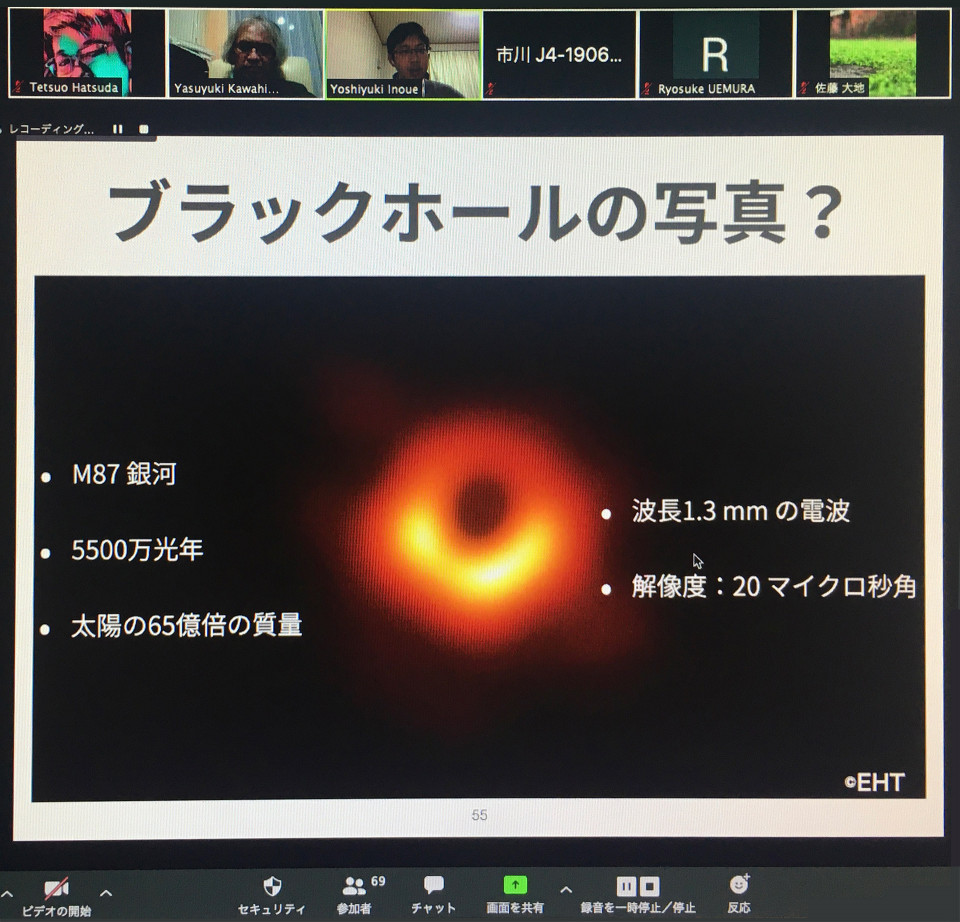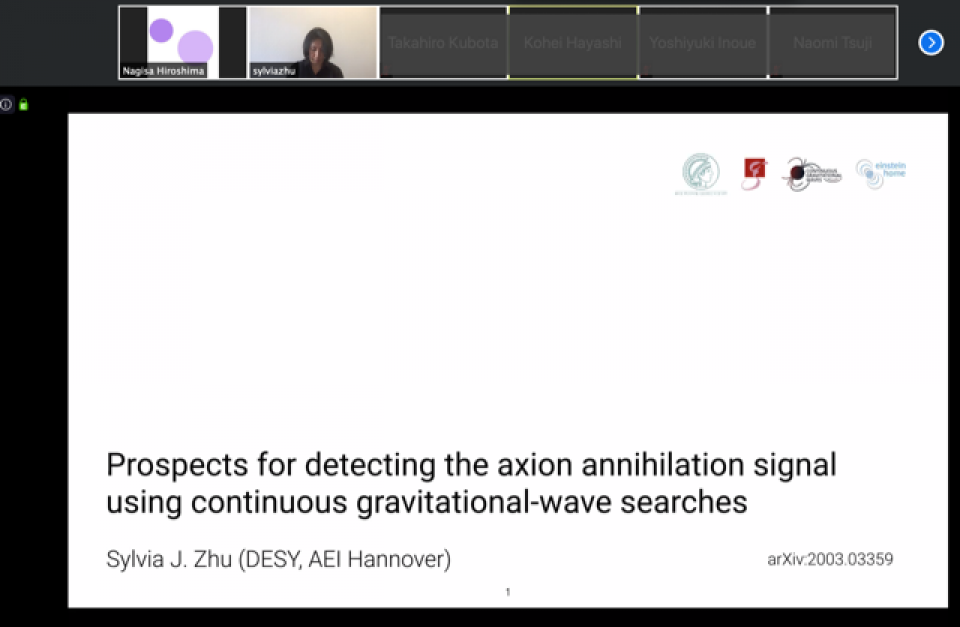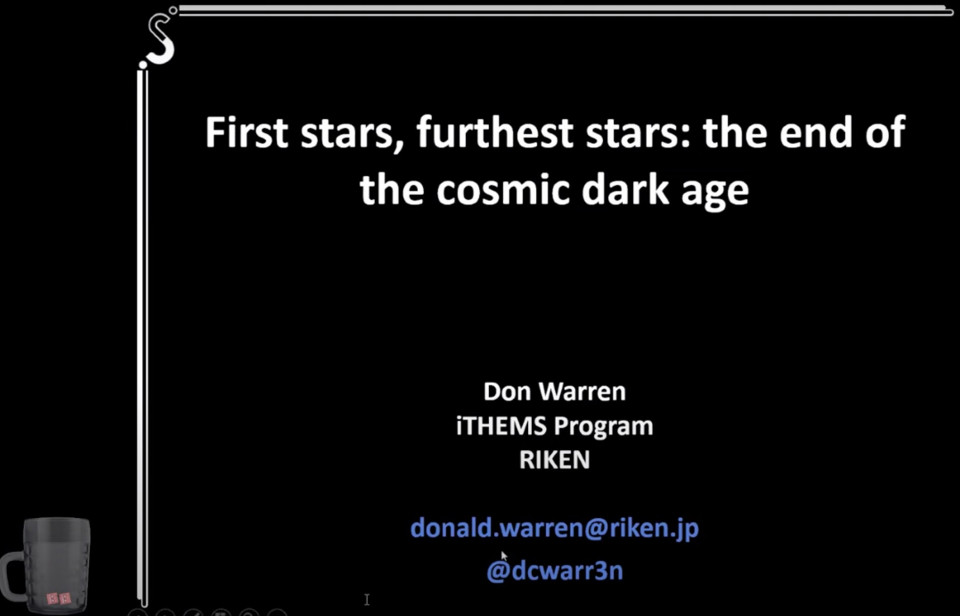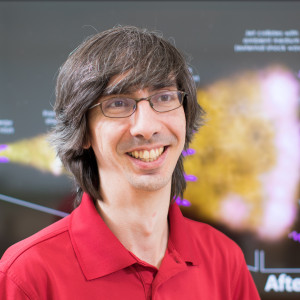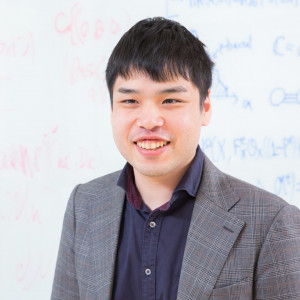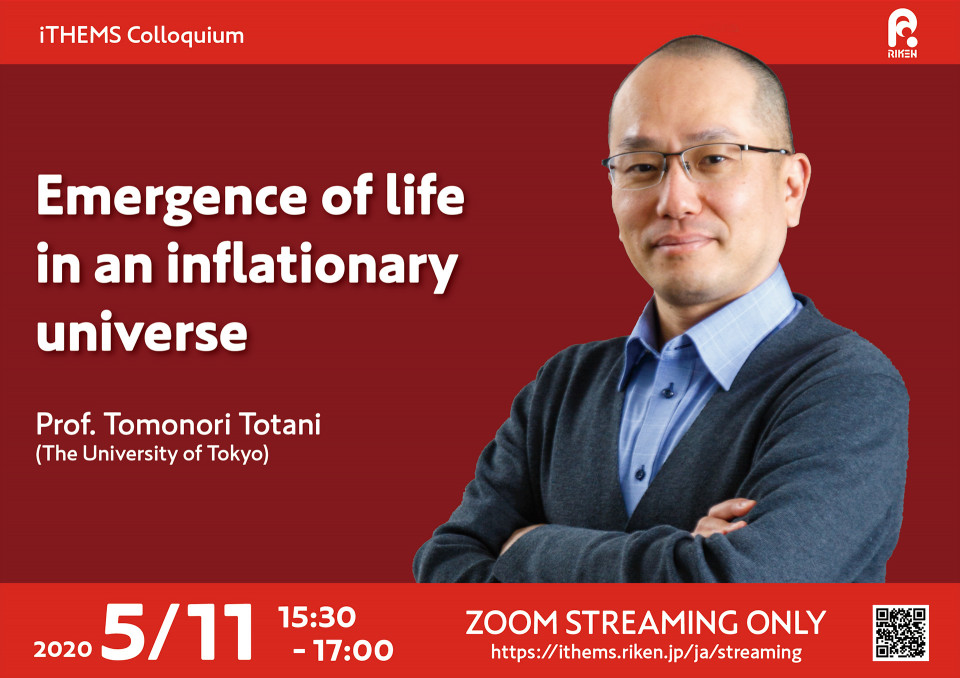Volume 101
Back to Newsletter List
Seminar Report
Frontier Science Lecture by iTHEMS Researchers
2020-04-30
Frontier Science Lecture by iTHEMS Researchers for undergraduate students in Univ. of Tokyo was started on April 22, 2020. This year, Yoshiyuki Inoue gave an online lecture on "the History of the Universe looking through the Black Holes". He started the lecture from ancient views of the Universe including the old Japanese tale that the Universe began from the Chaos. Then he moved on to the modern view of the Universe and Matter based on the theory of general relativity and also quantum mechanics. After explaining recent observations of the black holes, he ended his lecture by saying that we are now entering the era of black hole astronomy.
On April 29 (although it was a national holiday), Yoshiyuki's lecture was followed by Yoshimasa Hidaka's lecture on "the Origin of Matter". His second lecture will be held on May 13.
Frontier Science Lectures in 2018 and 2019 can be checked from the web site below. The 2018 lecture will be published from the Univ. of Tokyo Press in the summer of 2020.
Seminar Report
Searching the signature of the ultra-light axions using gravitational waves
2020-04-28
As the first activity of the DM working group in the academic 2020, we have held an online seminar inviting Dr. Sylvia Zhu from DESY. She has introduced her recent work about the axion search using the continuous gravitational waves, which is a new connection between the particle and the gravitational-wave physics.
Axions and axion-like particles are good candidates for dark matter, which could simultaneously solve the strong CP problem. When such particles exist around spinning black holes (BHs), they can extract the angular momentum of the BH through the so-called superradiance. In this mechanism, the amplitude of the axion oscillation increases because the wave is scattered off by the rotating BH. Especially for the case of the axion/axion-like particle, this scattering leads to the multiple particle production hence they form a cloud-like structure around the BH, which resembles the electron cloud of the atom. Such a BH-axion cloud object can be the source of the continuous gravitational wave since axions in the cloud are converted to gravitons when they pair-annihilate.
The detection of the continuous gravitational wave is really difficult. The key quantities for the detectability are the strength of the gravitational wave and the duration. In addition, the cloud-formation condition has to be satisfied. The larger the mass of the axion as well as the BH is better to form such systems. Also, the strength of the gravitational wave increases along with the mass of the system and the spin of the central BH. On the other hand, the decaying timescale of the gravitational wave emission becomes shorter for heavier systems hence there is a competition between these effects.
Combining the mass and spin distribution of the BHs in our Galaxy, we could expect about 100-1000 continuous gravitational-wave signals generated in the axion clouds. We can probe the axion/axion-like particle of which mass is 0.1-1 pico-eV using this method. The sensitivity with the LIGO-Virgo facilities peaks at ~0.5 pico-eV. We could see the signatures of the new physics and/or the hint of dark matter by conducting intensive analyses.
Characterizing the continuous gravitational-wave signal from boson clouds around Galactic isolated black holes
April 27 (Mon) 16:00 - 17:00, 2020
Seminar Report
Nerd Night Tokyo: public talk by Don Warren
2020-04-30
At Nerd Night Tokyo on April 22, Don Warren gave a public talk on "First stars". You can watch his superb lecture from YouTube. Enjoy!
Upcoming Events
Seminar
iTHEMS Math Seminar
From Eigenvalues to Resonances
May 1 (Fri) 16:00 - 18:10, 2020
Keita Mikami (Research Scientist, RIKEN Interdisciplinary Theoretical and Mathematical Sciences Program (iTHEMS))
Resonance is one of the most studied object in mathematical study of Schrödinger operators. One possible reason is that resonance is appeared in many other fields like arithmetic, physics, and topography. This series of talks target both mathematicians and researchers in other fields. The goal of the talk is to introduce the study of resonances for two body Schrödinger operators.
In the first part, we briefly review spectral theory and how we use it in the study of Schrödinger operators. The aim of this part is to introduce the audience some basic notions used in the study of Schrödinger operators.
In the second part, we give brief introduction of resonances and its application to both mathematicians and researchers in other fields. We start from mathematical definition of resonances to its applications in the other fields.
Venue: via zoom
Event Official Language: English
Colloquium
iTHEMS Colloquium
Emergence of life in an inflationary universe
May 11 (Mon) 15:30 - 17:00, 2020
Tomonori Totani (Professor, Department of Astronomy, Graduate School of Science, The University of Tokyo)
The origin of life may be the greatest mystery in natural science. Especially, we know almost nothing about how the first biological molecule (possibly an RNA) appeared from abiotic chemical processes. A widespread notion is that the abiogenesis probability is extremely low when we consider only random chemical reactions to polymerize a large biological molecule. However, we do not know any more efficient polymerization process expected to work in a realistic prebiotic environment. Here, I consider this problem from a viewpoint of cosmology. Cosmologists agree that the universe created by an inflation should extend far beyond the observable universe (13.8 billion light year radius). Then the inflationary universe may be sufficiently large to produce many abiogenesis events, even if we consider only the basic random polymerization. I will give a quantitative answer to this question, and discuss various implications about the origin-of-life studies.
Venue: via Zoom
Event Official Language: English
Paper of the Week
Week 5 of April
2020-04-30
Title: Resummation for the Field-theoretical Derivation of the Negative Magnetoresistance
Author: Kenji Fukushima, Yoshimasa Hidaka
arXiv: http://arxiv.org/abs/1906.02683v2
Title: The Gromov-Lawson codimension 2 obstruction to positive scalar curvature and the C*-index
Author: Yosuke Kubota, Thomas Schick
arXiv: http://arxiv.org/abs/1909.09584v2
Title: An Analytic Description of Semi-Classical Black-Hole Geometry
Author: Pei-Ming Ho, Yoshinori Matsuo, Yuki Yokokura
arXiv: http://arxiv.org/abs/1912.12855v3
Title: Partial wave decomposition on the lattice and its applications to the HAL QCD method
Author: Takaya Miyamoto, Yutaro Akahoshi, Sinya Aoki, Tatsumi Aoyama, Takumi Doi, Shinya Gongyo, Kenji Sasaki
arXiv: http://arxiv.org/abs/1906.01987v2
Title: How the deprecation of Java applets affected online visualization frameworks -- a case study
Author: Martin Skrodzki
arXiv: http://arxiv.org/abs/2004.13254v1
If you would like to cancel your subscription or change your email address,
please let us know via our contact form.
Copyright © iTHEMS, RIKEN. All rights reserved.


